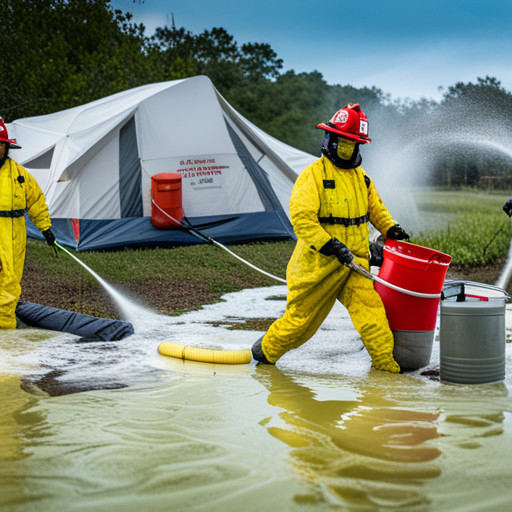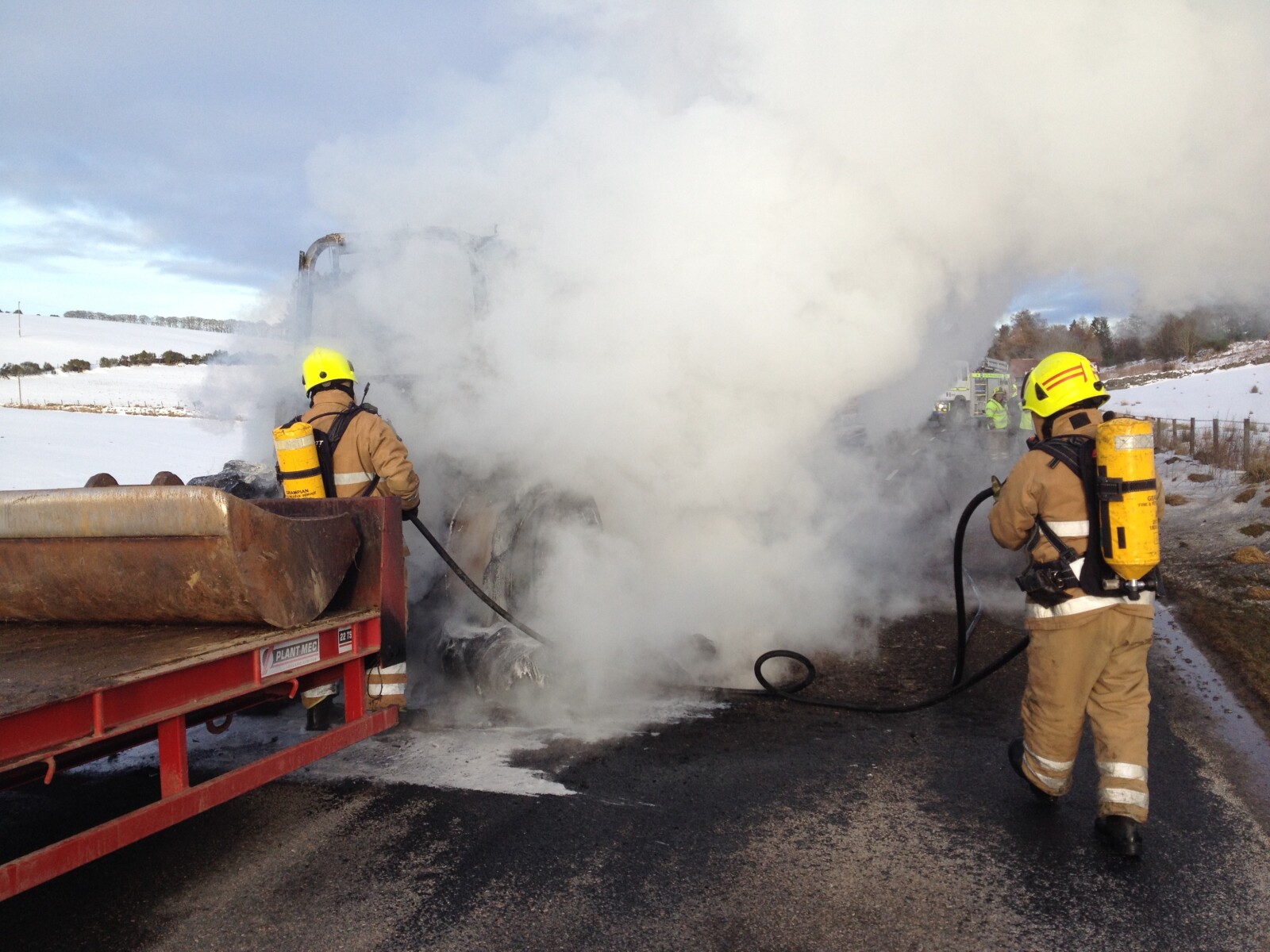Thyroid Cancer Due to AFFF
Thyroid cancer, characterized by the malignant growth of thyroid gland cells, has emerged as a pressing health issue with potential links to environmental exposures. Among these, the use of Aqueous Film Forming Foam (AFFF) by firefighters is particularly concerning. AFFF contains per- and polyfluoroalkyl substances (PFAS), which have been associated with multiple health risks, including thyroid cancer.

These substances interfere with thyroid hormone homeostasis and metabolism, raising the incidence of cancer among those frequently exposed. This introduction seeks to elucidate the connection between AFFF exposure and increased thyroid cancer risk, highlighting the need for further research and support for affected individuals in the pursuit of health remedies and legal compensation.
Key Takeaways
- Thyroid cancer is nearly 3 times more common in women than in men.
- Causes of thyroid cancer include a low iodine diet, exposure to radiation, genetics, being female, and AFFF exposure in civilian and military firefighters.
- Firefighters exposed to AFFF are more prone to developing thyroid disease.
- PFOA, a toxic chemical found in AFFF, inhibits the accumulation of iodine by thyroid follicular cells, increasing the risk of thyroid cancer.
Understanding Thyroid Cancer
Understanding thyroid cancer involves recognizing its complex etiology, which, in the context of AFFF exposure, includes the detrimental role of PFAS on the endocrine system. Thyroid cancer treatment is multidisciplinary, often necessitating surgical intervention, radioactive iodine therapy, and thyroid hormone suppression therapy. These modalities are informed by the molecular profile and staging of the tumor, underscoring the importance of precision medicine in optimizing patient outcomes.
Prevention strategies, however, are pivotal in mitigating risk, particularly for those with occupational hazards. Limiting AFFF exposure, employing protective equipment, and advocating for PFAS-free fire suppressants can reduce incidence rates. Evidence-based analysis of AFFF's impact on thyroid pathology fortifies the imperative for stringent regulatory measures and robust health surveillance of at-risk populations.
Key Thyroid Cancer Statistics

In the United States, among the 43,720 annual cases of thyroid cancer, a significant portion is attributed to occupational exposure to Aqueous Film Forming Foam (AFFF). This foam, predominantly used for firefighting, contains per- and polyfluoroalkyl substances (PFAS) which are linked to endocrine disruption and carcinogenesis. The incidence of thyroid cancer has escalated, prompting intense scrutiny of environmental factors, especially in high-risk occupations.
Thyroid cancer prevention strategies are increasingly focusing on minimizing exposure to AFFF and related chemicals. Concurrently, advancements in treatment, such as targeted therapies and precision medicine, have improved the prognosis for affected individuals. These developments underscore the need for a dual approach that combines rigorous preventive measures with sophisticated treatment options to address the growing concern of thyroid cancer related to AFFF exposure.
Common Causes of Thyroid Cancer
Among the various etiological factors for thyroid cancer, exposure to Aqueous Film Forming Foam (AFFF) remains a significant concern due to its high content of per- and poly-fluoroalkyl substances (PFAS), known to disrupt endocrine function and increase cancer risk. The following factors outline additional common causes of thyroid cancer:
- Genetic predispositions: Familial history and specific genetic mutations heighten susceptibility.
- Radiation exposure: Therapeutic or accidental radiation to the neck area, particularly during childhood.
- Iodine consumption: Both deficiency and excess can influence thyroid cancer development.
- Hormonal factors: Higher incidence in females suggests hormonal influences play a role.
Strategies for thyroid cancer prevention should address these risk factors, and treatment options need to be tailored to patient-specific profiles, ensuring a precise and effective approach to management and care.
The Role of AFFF Exposure
While AFFF has been crucial for firefighting operations, its high levels of PFAS have been linked to an increased risk of thyroid cancer in those with occupational exposure. A robust risk assessment framework is necessary to understand the extent of the threat posed by long-term exposure to AFFF. Prevention measures must be put in place to minimize contact with PFAS-containing foam, especially for firefighters who are at a heightened risk. Here is a breakdown of key considerations in assessing the risk and implementing preventive strategies:
| Consideration | Description |
|---|---|
| Occupational Exposure | Duration and frequency of AFFF use in work. |
| Personal Protective Equipment (PPE) | Use of PPE to minimize skin and inhalation exposure. |
| Medical Surveillance | Regular health screenings for early detection. |
| Training and Awareness | Education on proper handling and risks of AFFF. |
| Policy and Regulation | Implementation of stricter controls on AFFF use. |
Evidence-based strategies must be integrated into firefighting protocols to mitigate the impact of AFFF on thyroid health.
PFAS: Persistent Health Risks
Persistent health risks associated with PFAS exposure from AFFF remain a critical concern for firefighters, as these chemicals can accumulate in the body and have long-lasting effects on thyroid health. The technical analysis of PFAS compounds reveals their ability to resist environmental degradation, leading to bioaccumulation and potential disruption of endocrine function. In the context of firefighter compensation, the understanding of PFAS implications is crucial for addressing health repercussions.
- Bioaccumulation: PFAS accumulates in the body, increasing the risk of thyroid dysfunction over time.
- Endocrine Disruption: PFAS mimic hormones, potentially altering thyroid hormone homeostasis.
- Cancer Risk: Long-term PFAS exposure is linked to an elevated risk of thyroid cancer.
- Firefighter Compensation: Legal frameworks are evolving to address the health impacts of PFAS on firefighters, including compensation claims.
Thyroid Function and PFAS
Since PFAS chemicals are known to disrupt endocrine activity, their presence in AFFF has become a significant concern regarding thyroid function and cancer risk. Understanding endocrine disruptors, specifically PFAS, is crucial as they can mimic or interfere with the body's hormone system. PFAS and thyroid function are intricately linked; these chemicals have the potential to alter thyroid hormone synthesis and metabolism. Research indicates that exposure to PFAS, particularly PFOA, can inhibit the thyroid's ability to accumulate iodine, a critical element for hormone production. This disruption may lead to thyroid dysregulation and an increased propensity for cancerous growth. Thus, analyzing the extent of PFAS impact on thyroid health is essential for developing strategies to mitigate these risks.
Firefighters’ Increased Risk

Firefighters, routinely exposed to Aqueous Film Forming Foam (AFFF) in their line of duty, face a heightened risk of developing thyroid cancer due to the presence of perfluoroalkyl substances (PFAS) in the foam. These chemicals, known for their persistence and bioaccumulation potential, have sparked significant AFFF exposure concerns, particularly regarding firefighters' health risks.
- Bioaccumulation and Persistence: PFAS amasses in the body over time, increasing the risk of cancer with prolonged exposure.
- Endocrine Disruption: PFAS act as endocrine disruptors, potentially leading to thyroid dysregulation and subsequent carcinogenesis.
- Protective Gear Inadequacy: Standard firefighting gear may not fully prevent PFAS absorption, leaving firefighters vulnerable.
- Health Monitoring Imperative: Regular health screenings are critical for early detection and intervention in affected firefighters.
Comprehensive understanding and mitigation strategies are imperative to protect this at-risk group.
PFOA’s Impact on Thyroid
Often implicated in thyroid dysfunction, perfluorooctanoic acid (PFOA) is a key component in AFFF that disrupts thyroid hormone homeostasis and raises the risk of thyroid cancer. Research indicates that PFOA exposure correlates with altered thyroid hormone levels, indicative of endocrine disruption. The mechanism involves PFOA's interference with iodine uptake and thyroid hormone synthesis. PFAS compounds, including PFOA, exhibit structural similarities to fatty acids, allowing them to integrate into biological systems and disrupt normal hormonal functions. This disruption is significant because thyroid hormones are critical for metabolism, growth, and development. Accumulating evidence from both epidemiological and laboratory studies substantiates PFOA's impact on thyroid health, underscoring the urgency for affected individuals, especially firefighters, to understand these risks and seek appropriate medical evaluation.
AFFF Exposure Duration Concerns
Evaluating the duration of AFFF exposure is critical in assessing the heightened risk of thyroid cancer among firefighters. Current afff exposure duration research indicates a clear correlation between the length of time firefighters are in contact with Aqueous Film-Forming Foam (AFFF) and their susceptibility to developing thyroid cancer. An evidence-based analysis is fundamental to understanding the implications of AFFF on health and determining effective afff exposure prevention strategies.
- Intensity of Exposure: Prolonged periods of exposure correlate with increased absorption of PFAS.
- Frequency of Use: Regular engagement with AFFF during firefighting operations compounds risk factors.
- Preventative Measures: Implementation of safety protocols can mitigate exposure duration.
- Retrospective Data Analysis: Longitudinal studies of firefighters' health records enhance insight into exposure-cancer links.
Identifying Thyroid Cancer Symptoms

Recognizing the early signs of thyroid cancer, such as a palpable neck lump or persistent hoarseness, is vital for firefighters who have been exposed to Aqueous Film-Forming Foam (AFFF). Elevating thyroid cancer awareness and implementing early detection strategies are critical components in mitigating the adverse health outcomes associated with occupational exposure to PFAS-laden foams. Analytical vigilance for symptoms like difficulty swallowing, swollen lymph nodes in the neck, and voice changes is paramount.
These hallmark signs, when detected promptly, can enhance diagnostic accuracy and treatment efficacy. Firefighters who present with these clinical manifestations should undergo a thorough medical evaluation to ascertain the presence of thyroid neoplasms. Early intervention rooted in evidence-based practice improves prognosis and underscores the importance of occupational health surveillance in high-risk populations.
When to Seek Medical Advice
Consult a healthcare professional immediately if you experience symptoms indicative of thyroid cancer, such as a neck lump, hoarseness, difficulty swallowing, or swollen lymph nodes. Timely diagnosis is paramount for effective treatment and improved prognostic outcomes. The presence of these symptoms warrants a thorough clinical evaluation, potentially including imaging and biopsy, to establish a definitive diagnosis.
- Persistent Neck Lump: A growth in the thyroid region that does not resolve over time.
- Voice Changes: Persistent hoarseness or other vocal alterations.
- Swallowing Difficulties: A sensation of obstruction or discomfort when swallowing.
- Enlarged Lymph Nodes: Noticeable swelling of lymph nodes in the neck area.
An evidence-based approach to symptoms enables early identification of thyroid pathology and informs subsequent diagnostic steps.
Support for Affected Firefighters

Firefighters who have been exposed to AFFF and are now grappling with thyroid cancer may be entitled to specialized support and compensation for their condition. These individuals must have access to robust support resources that address both the medical and legal complexities of their cases. Evidence-based approaches underscore the importance of firefighter advocacy groups, which play a crucial role in educating and assisting affected firefighters in navigating the intricacies of compensation claims. These organizations are instrumental in providing technical expertise, and ensuring firefighters receive accurate information and guidance. In analyzing the current landscape, strategic partnerships between medical professionals and legal experts are essential in advocating for the rights and benefits of firefighters exposed to carcinogenic substances in AFFF.
Eligibility for Compensation
While firefighters must navigate the health repercussions of AFFF exposure, determining their eligibility for compensation is a critical step in addressing the financial and emotional toll of a thyroid cancer diagnosis. The process of establishing compensation eligibility is underpinned by a robust analysis of exposure history, medical evidence, and legal precedents.
Key considerations for firefighters include:
- Documented proof of AFFF exposure during service.
- Medical diagnosis linking thyroid cancer to AFFF exposure.
- Understanding the statute of limitations for filing a claim.
- Access to specialized legal assistance to navigate complex litigation.
Firefighters seeking compensation must work closely with legal experts who have a deep understanding of the nuanced intersection between toxic exposure and occupational health law. This technical, evidence-based approach ensures that their cases are handled with the precision and diligence they deserve.
Legal Process for Firefighters
The initiation of legal proceedings for firefighters afflicted with thyroid cancer due to AFFF exposure necessitates a comprehensive understanding of pertinent laws and regulations. Securing proficient legal representation is critical for navigating the complexities of environmental tort law and product liability that govern such cases. Attorneys specializing in this field must possess the technical expertise to analyze evidence linking AFFF exposure to thyroid cancer, thus substantiating compensation eligibility claims. The legal process hinges on establishing causation between AFFF exposure and the resultant health condition, a task that demands rigorous analytical scrutiny of occupational and medical data. Firefighters pursuing justice must rely on legal counsel adept in marshaling scientific and epidemiological data to advocate effectively for their right to recompense.
Contacting Experienced Attorneys

For those seeking legal recourse for thyroid cancer attributed to AFFF exposure, enlisting the assistance of specialized attorneys is a crucial step. These legal professionals offer firefighter advocacy and legal representation rooted in technical expertise and evidence-based analysis. Their services are pivotal for navigating the complex legal landscape and establishing a link between AFFF exposure and thyroid cancer.
- Specialized Knowledge: Attorneys with experience in AFFF-related cases possess a deep understanding of the associated medical and legal issues.
- Evidence Gathering: They can expertly compile the necessary evidence to support claims of causation and liability.
- Strategic Litigation: Experienced lawyers develop tailored strategies to argue cases in court or negotiate settlements effectively.
- Firefighter Advocacy: Dedicated legal representation ensures that the rights and interests of firefighters are vigorously defended.
Frequently Asked Questions
What Are the Potential Environmental Impacts of AFFF on Local Ecosystems, and How Might They Indirectly Affect Human Health?
The environmental impacts of AFFF on local ecosystems include toxic runoff, which can contaminate soil and water bodies. This contamination can lead to bioaccumulation effects in wildlife, jeopardizing biodiversity and food web stability. These ecological disturbances may indirectly affect human health through the consumption of contaminated water or food sources, highlighting the need for rigorous analysis and management of AFFF usage to mitigate its detrimental ecological footprint.
Are There Any Dietary or Lifestyle Changes That Firefighters Can Adopt to Mitigate the Risks of Thyroid Cancer Associated With AFFF Exposure?
Firefighters may reduce thyroid cancer risks by implementing dietary and lifestyle modifications. Incorporating dietary antioxidants through fruits, vegetables, and supplements can combat oxidative stress caused by contaminants. Moreover, stress management techniques such as mindfulness, regular exercise, and adequate sleep can strengthen the immune system and potentially mitigate the impact of hazardous exposures. These proactive measures are based on general health recommendations and evidence linking lifestyle factors to cancer risk reduction.
What Kind of Long-Term Monitoring or Health Surveillance Programs Are in Place for Firefighters Who Have Been Exposed to AFFF?
Firefighter registries serve as vigilant sentinels, meticulously recording each exposure's imprint on those who battle blazes. These databases, underpinned by evidence-based protocols, ensure systematic exposure documentation, enabling health professionals to analyze and surveil the long-term impacts with technical acumen. Such surveillance programs are pivotal in safeguarding firefighters' well-being, offering an analytical lens through which to scrutinize the latent sequels of their heroic endeavors.
How Does the Risk of Thyroid Cancer From AFFF Exposure Compare to Other Common Occupational Hazards Faced by Firefighters?
When examining occupational hazards faced by firefighters, the risk of thyroid cancer from AFFF exposure must be weighed against risks associated with other elements like smoke inhalation and contact with carcinogens via firefighter gear. While genetic predisposition plays a significant role in cancer development, the technical analysis of epidemiological data indicates that exposure to AFFF presents a distinct and substantial risk factor for thyroid cancer among firefighters.
Can Family Members of Firefighters Be at Risk for Thyroid Cancer or Other Health Issues Due to Secondary Exposure to Contaminants From AFFF?
Could secondary contamination affect the health of firefighters' families? Indeed, family members may experience health issues, including potential thyroid irregularities, due to secondary exposure to contaminants brought home on clothing or equipment. This scenario underscores the critical importance of rigorous decontamination protocols to safeguard family health. Analyzing evidence from occupational studies reveals the necessity for heightened awareness and preventive measures in these environments.




